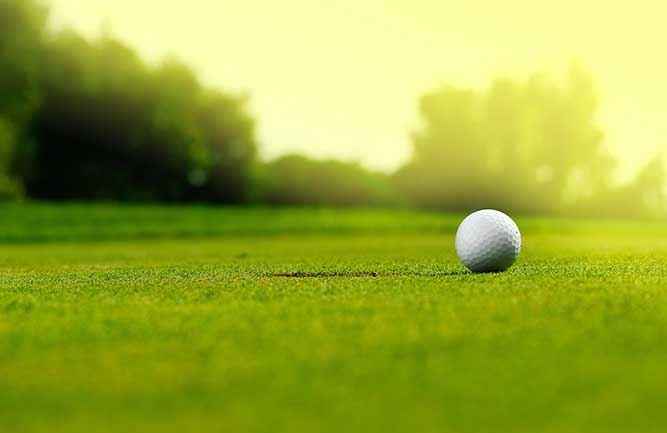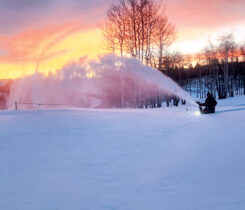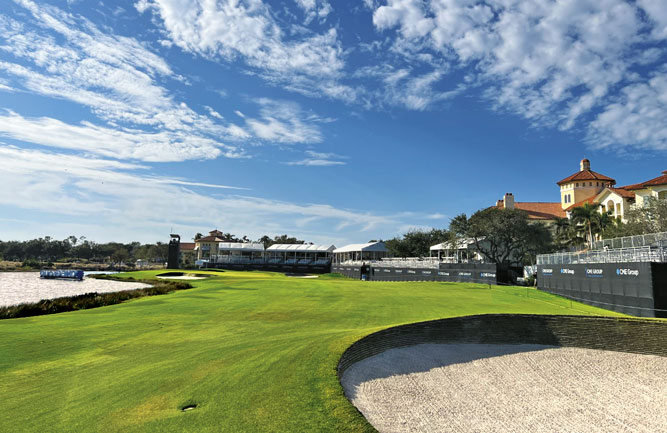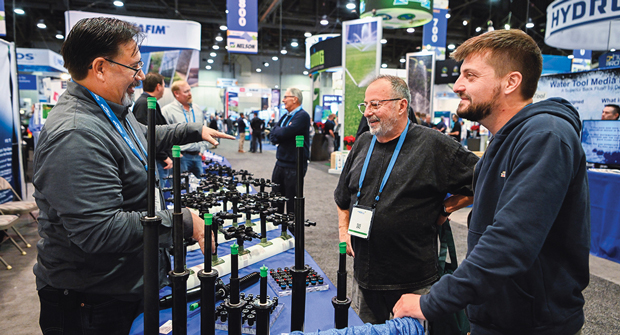How researchers are developing freeze-tolerant bermudagrass
Winterkill is used to define turfgrass loss during the winter. Winterkill or winter survivability depends on various factors, including crown hydration, desiccation, direct low temperatures, ice sheets and snow mold disease.
Replacing damaged turfgrass lost to winterkill is labor intensive and expensive. Intensively managed areas such as golf courses are predisposed to winterkill due to aggressive fertilization programs, low mowing heights and vehicular and foot traffic.
Bermudagrass (Cynodon spp.) is the most commonly used warm-season turfgrass on golf courses in the Transition Zone of the U.S. Bermudagrass has excellent tolerance to heat and drought but low tolerance to freezing temperature. Developing bermudagrasses with better freeze tolerance is a priority of bermudagrass breeding programs.
Previous research at Oklahoma State University (OK State) and North Carolina State University (NC State) reported significant variation in freeze tolerance for bermudagrass cultivars. Many of these experiments determining the freeze tolerance of bermudagrass used controlled environmental chambers to estimate the temperature to kill 50 percent of the population (LT50). The research results demonstrate that genetic improvement is possible in bermudagrass breeding programs.
The LT50 values obtained in the controlled environment experiments showed a significant negative correlation to spring greenup and a positive correlation to winterkill estimated in the field. Although field evaluations are typical for breeders to assess winter survivability of genotypes in large nurseries, environmental conditions in field experiments are unpredictable and difficult to replicate.
Controlled environment experiments can quickly identify genotypic differences in freezing tolerance based on exposure to direct freezing temperatures. Therefore, the objective of this experiment was to determine the LT50 values of two experimental interspecific hybrid bermudagrass genotypes and two commercially available cultivars by exposing these to 11 target freezing temperatures (25 to 7 degrees F) under controlled environment conditions.
Plant materials and growing conditions
The entries in this experiment consisted of two experimental genotypes, OKC1873 and OKC1406, developed by the bermudagrass breeding program at OK State, and two industry standards, Tifway (freeze-sensitive) and Tahoma 31 (freeze-tolerant).
The experiment was replicated in time, with staggered planting to allow uniform establishment periods. We clonally propagated all of the entries in potting mix within conetainers (8.25-inch depth and 1.5-inch diameter). The propagation material used in each conetainer was a single sprig consisting of a root, crown and shoot material.
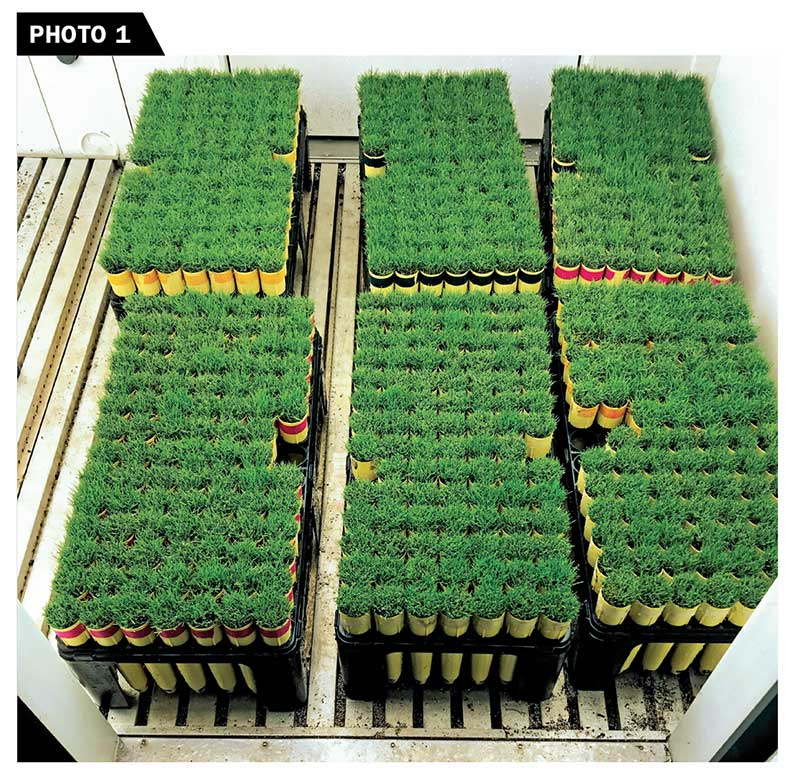
Bermudagrass entries were established in a growth chamber at 32/28-degree F day/night temperatures for 13 weeks. (Photo: Lakshmy Gopinath, Ph.D.)
We established the bermudagrass entries in a PGC Flex growth chamber at the OK State Controlled Environment Research Laboratory, Stillwater, Okla., (Photo 1). The growth chamber was maintained at 32/28 degrees F day/night temperatures for 13 weeks with a photoperiod of 14 hours and photosynthetically active radiation (PAR) of 900 μmol m-2s-1.
The conetainers were adequately fertilized weekly with a general-purpose 20–10–20 N–P–K fertilizer (J.R Peters) and trimmed to maintain a 1-inch height. During the establishment phase, the conetainers were treated every 14 days with Talstar (bifenthrin) as a precautionary measure.
At the end of 13 weeks, the temperatures were lowered to 75/68 degrees F day/night for a week to preacclimate the conetainers before cold acclimation. We then subjected conetainers to cold acclimation by lowering the temperature to 46/36 degrees F day/night for four weeks with a photoperiod of 10 hours and a PAR of 400 μmol m-2s-1.
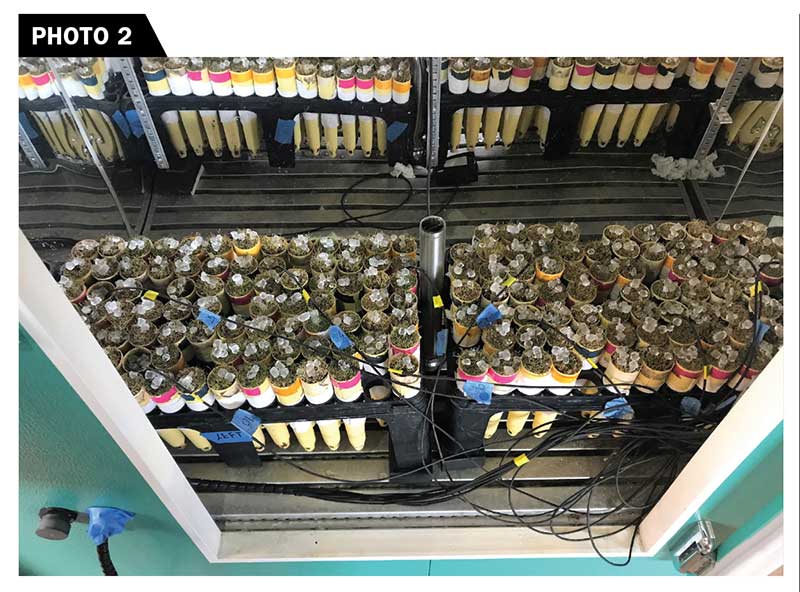
Conetainers were placed into a freeze chamber with 10 randomly placed thermocouple sensors inserted 1 inch into the potting medium. Ice chips are in all of the conetainers to prevent supercooling and induce freezing.(Photo: Lakshmy Gopinath, Ph.D.)
Freeze treatment
After cold acclimation, we placed the conetainers into a freeze chamber (Conviron E8). Ten thermocouple sensors were inserted 1.0 inches into the potting medium at the center of randomly selected conetainers to monitor the soil temperature. We put small ice chips in all of the conetainers to prevent supercooling and induce freezing (Photo 2).
The freeze chamber was programmed to stay at 27 degrees F for 18 hours for the dissipation of latent heat and then cool linearly at the rate of 1.8 degrees F per hour. The 11 target temperatures (1.8-degree F intervals, 25 to 7 degrees F) covered a range anticipated to span the limits from complete survival to complete mortality.
We removed four conetainers of each entry (16 conetainers in total) immediately at each target temperature. These conetainers were then placed in a plant growth chamber set at 39 degrees F overnight to induce thawing.
The temperature was then increased to 75/68 degrees F for a week and afterward to 90/82 degrees F to encourage recovery (Photo 3). The regrowth based on shoot emergence was visually evaluated after five weeks using binary values (1 = alive, 0 = dead).
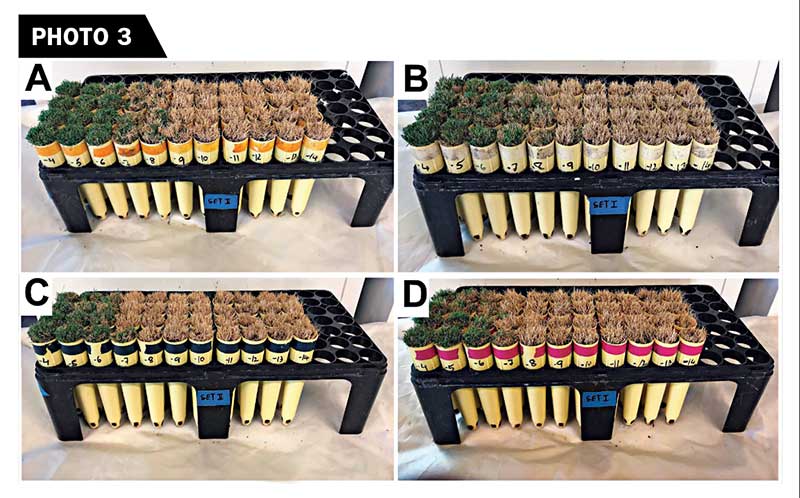
The temperature was then increased to 75/68 degrees F for a week and afterward to 90/82 degrees F to encourage recovery. The regrowth based on shoot emergence was visually evaluated after five weeks using binary values (1 = alive, 0 = dead). A = Tahoma 31, B = OKC 1406, C = Tifway and D = OKC 1873. (Photo: Lakshmy Gopinath, Ph.D.)
Experimental design and statistical analysis
We determined the LT50 values for each entry using a logistic regression procedure. This statistical procedure generated a table of predicted percent survival at each temperature, and the temperatures corresponding to 50 percent survival are the estimates of LT50 for each entry.
We repeated the freeze test three times to produce three estimated LT50 values for each entry. The LT50 of each replication was treated as a response variable and tested for statistical significance. The entry means were separated using Fisher’s protected LSD when F tests were significant at P ≤ 0.05.
Results and discussion
There were significant differences among the entries in the LT50 values. Tifway had the highest LT50 or low freeze tolerance (Table 1), similar to the range of 18 to 17.6 degrees F previously reported for this cultivar at OK State. However, the LT50 value was 22.3 degrees F obtained by NC State, and the discrepancy may be due to the differences in acclimation temperatures and recovery periods between the two experiments. The samples in their experiment had a shorter
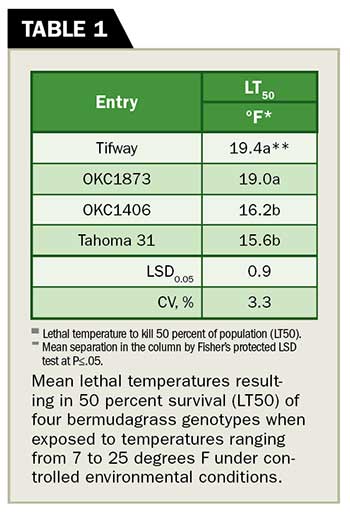
(Graphic: Golfdom Staff)
establishment period, and they acclimated the samples at a higher temperature.
The lower acclimation temperatures in our experiment could have induced a greater level of acclimation. Also, in the NC State experiment, multiyear (2011–2015) field testing results indicated that Tifway had the highest winter survival among four commercial standards (Patriot, Tifsport, Quickstand and Tifway) in 2013, 2014 and 2015. This conflicts with other national reports, which showed that Tifway had high winterkill percentages in Indiana and Kentucky. The inconsistency in the winter survival of Tifway could be due to the differences in environmental conditions and genotype X environment interactions during the acclimation period and the winter.
The low LT50 value of Tahoma 31 is consistent with field observations, exhibiting the least winterkill percentage of 4 percent and 25 percent in Indiana and Kentucky, respectively, with superior post-dormancy regrowth. Tahoma 31 quickly recovered and reached 75 percent green coverage within 22 days after chilling stress removal, indicating high recovery potential after freezing temperatures. The LT50 values of Tahoma 31 in this experiment were similar to results obtained in previous experiments at OK State.
Tahoma 31 had a turfgrass quality rating above six in five out of seven locations in the preliminary data of the National Turfgrass Evaluation Program’s warm-season putting trial, indicating its ability to tolerate a height of cut above 0.125 inches. With the low LT50 reported in this experiment and the ability to handle a 0.125-inch height of cut, Tahoma 31 could serve as an ideal cultivar for fairways and lower maintenance putting greens in the U.S. Transition Zone.
The LT50 of OKC1873 was not significantly different from Tifway, suggesting its range of use should be similar to Tifway (Table 1). OKC1406 was in the same statistical group as Tahoma 31. The result is consistent with a previous report in which OKC1406 was ranked sixth among 53 experimental genotypes for winter survival tested in Kansas (17). OKC1406 had a higher winter survival percentage (88.3 percent) than industry standards Tifway (0 percent), Latitude 36 (20 percent), NorthBridge (25 percent), Patriot (30 percent) and TifTuf (23 percent).
The higher winter survival percentage of OKC1406 than some of the current industry standards and the LT50 value similar to Tahoma 31 in this experiment indicate its high freeze tolerance. However, multilocation and multiyear testing of the experimental genotypes is required to evaluate turfgrass quality, mowing tolerance and pest and disease resistance.
Conclusion
The controlled environment investigation revealed that OKC1406 was as freeze tolerant as Tahoma 31, whereas OKC1873 had a freeze tolerance similar to Tifway. These evaluations provide valuable information for plant breeders to decide whether the experimental bermudagrass genotypes tested should be subjected to further evaluation. Using freeze-tolerant bermudagrass genotypes will help golf courses decrease costs associated with reestablishing turfgrass lost to winter injury.
Acknowledgments
The authors wish to thank the following supporters of this research: Oklahoma Center for the Advancement of Science and Technology, the United States Golf Association, Oklahoma Agricultural Experiment Station and the USDA NIFA, Hatch Project OKL03146.









